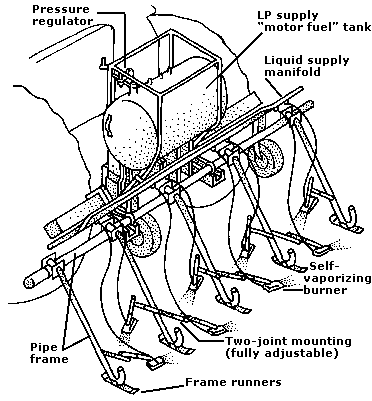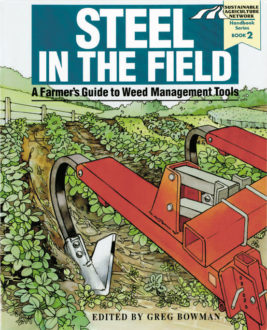Agronomic Row Crops
Hot Tips for Flame Weeding
If flaming is a new technology for you, learn all you can about its principles, hardware and management from farmers, manufacturer reps, local LP-gas technicians and hands-on demonstrations. Competence, confidence and regular maintenance checks are the basis for safe operation of LP-gas tools. Keep these suggestions in mind as you select your equipment and set up your field for flame weeding.
1. Choose hardware to fit your weeding needs. The rate of fuel consumption per acre is influenced by burner capacity (measured in BTUs per hour), air temperature, gas pressure, plant surface moisture and the size of weeds being targeted. Compared with dry seedling weeds, wetter weeds and bigger weeds are harder to kill. You can deliver more heat with a slower tractor speed (giving a longer flame exposure), more gas pressure (giving a more intense exposure), or a combination of both.
Flame-weeding specialists or burner manufacturers can help you select the burner type, regulator setting, tank size and overall set-up that fits your combination of weeds, crops, soil condition and field size. Always use 'motor fuel' rated tanks (approved by the U.S. Department of Transportation) for tractor mounting.
Fuel use can vary from 3 to 14 gallons per acre, depending on the intensity of the flaming and how extensive the coverage (a narrow band along the rows, or broadcast coverage of the entire swath).
2. Add cultivators with caution. Burners positioned behind cultivator shanks may enhance the benefit of cultivation, but probably will decrease the kill rate that flaming alone would have achieved. The moving soil and dust tend to deflect heat from the weed leaves. Running the burners out in front of the cultivator sweeps can also reduce the flaming kill rate. Weeds wilted by the flame that would dry out on the surface may recover if they are buried and protected by loose, moist soil.
3. Prevent flame deflection. Soil contour next to the row must be smooth and on a fairly consistent angle to assure optimum weed kill and minimum plant damage. Protruding clods or uneven terrain may shield small weeds or deflect flame into the plant canopy.
4. Lightness adds flexibility. Some farmers mount flamer parts on old cultivator toolbars - an inexpensive option, but often much heavier than needed. Mounting the burners and the tank on a simple pipe frame with runners makes a lighter unit that can be used in wetter soil conditions or with a smaller tractor.
Row-Crop Flamer
Agronomic Row Crops Row-Crop Flamer
(standard U.S. LP-gas, liquid feed)
Overview: Flames from LP-gas burners kill plants by rupturing cell walls, not burning plant tissue. Flaming is most effective on broadleaf weeds as small seedlings. It is less effective against grasses, and least effective on sedges and weeds that branch at ground level. Broadcast flaming can cover an entire bed or toolbar width prior to crop emergence. Directed flaming targets a specific zone between crop rows or in-row beneath plants after they develop a heat-resistant stem.

Design Features: LP gas flows as a liquid that vaporizes in high-BTU burners. This arrangement avoids the 'freeze-up' potential of vapor-withdrawal systems, caused when gas is burned faster than it can vaporize directly from the main tank. Burners can be mounted on steel-frame skids or on cultivator toolbars. Tanks must be motor-fuel rated. Do not use stationary propane tanks.
Model for comparison: 15' with gauge wheels Rec. PTO HP: 70 Speed: 3 to 5 mph List price: $2,400 to 5,500 Width range (all makers/all models): 4' to 30'
Operating Cost: 3 to 14 gallons per acre per application, depending on tractor speed and gas pressure, which are in turn influenced by crop, field and wind conditions. Code-complying tanks range in price from $275 (used 110 gal.) to $550 (new 250 gal.). Tank rental $25 to $60 per season, where available from LP-gas or crop-protection material companies. Two or three applications per season are normal; more may be necessary, depending on weed pressure.
Farmers: de Wilde, Foster, Harlow, McKaskle, Thacker Also: See hand flamers a b.
NOTE: Fueling renewed interest in flaming are herbicide-resistant weeds and regulations on worker pesticide safety and water pollution. Flamers pose no threat of carryover or runoff but do require a thorough understanding of LP gas safety.
